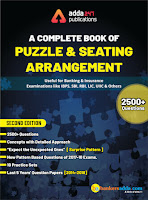Reasoning Questions for IBPS RRB 2019
Reasoning Ability is a crafty section. It eventually affects the number of question one can usually attempt. But this section is based on logic and rules can be aced if practised well enough. The only way to achieve this ambitious goal is by practising continuously with dedication. So to prepare you with best tools for the finals, here is today’s Reasoning Quiz based on the study plan and the exact same pattern of questions that are expected to be asked in IBPS RRB PO and Clerk Exam.
Directions (1-5): In these questions, relationship between different elements is show in the statements. The statements are followed by conclusions. Study the conclusions based on the given statements and select the appropriate answer:
Q1. Statements:
A>S>D>H>U=Y>T<E≤R
Conclusion
I: A>Y
II: H>E
If only conclusion I follows.
If only conclusion II follows.
If either conclusion I or II follows
If neither conclusion I nor II follows.
If both conclusions I and II follow.
Solution:
I:
A>Y(True) II:
H>E(False)
A>Y(True) II:
H>E(False)
Q2. Statements:
G=T≥Y>U≥C≥M<J<W=L
Conclusion
I: G≥M
II: L>J
If only conclusion I follows.
If only conclusion II follows.
If either conclusion I or II follows
If neither conclusion I nor II follows.
If both conclusions I and II follow.
Solution:
I: G≥M (False) II:
L>J (True)
L>J (True)
Q3. Statements:
T>B>M>Q=P<O=I>Z<X
Conclusion
I: B>O
II:
O≤B
O≤B
If only conclusion I follows.
If only conclusion II follows.
If either conclusion I or II follows
If neither conclusion I nor II follows.
If both conclusions I and II follow.
Solution:
I: B>O
(False) II: O≤B (False)
(False) II: O≤B (False)
Q4. Statements:
K<J≤A>Z>M≥X≥B≥C=V
Conclusion
I: V<M
II:
M=V
M=V
If only conclusion I follows.
If only conclusion II follows.
If either conclusion I or II follows
If neither conclusion I nor II follows.
If both conclusions I and II follow.
Solution:
I:
V<M (False) II. M=V(false)
V<M (False) II. M=V(false)
Q5. Statements:
Q>G>H=N>S≥I≤L≥M>R
Conclusion
I: S<G
II:
Q>I
Q>I
If only conclusion I follows.
If only conclusion II follows.
If either conclusion I or II follows
If neither conclusion I nor II follows.
If both conclusions I and II follow.
Solution:
I: S<G
(True) II: Q>I (True)
(True) II: Q>I (True)
Directions (6-10): In these questions, relationship between different elements is show in the statements. The statements are followed by conclusions. Study the conclusions based on the given statements and select the appropriate answer:
Q6. Statements:
W=E>F>V, M≥W, G≥S≥V
I: E≤M
II: M>S
If only conclusion I follows.
If only conclusion II follows.
If either conclusion I or II follows
If neither conclusion I nor II follows.
If both conclusions I and II follow.
Solution:
I:
E≤M(true) II:
M>S(False)
E≤M(true) II:
M>S(False)
Q7. Statements:
H≤R, T<U≤H, H<I<R
Conclusion
I: I≥T
II: I>T
If only conclusion I follows.
If only conclusion II follows.
If either conclusion I or II follows
If neither conclusion I nor II follows.
If both conclusions I and II follow.
Solution:
I: I≥T (False) II: I>T
(True)
(True)
Q8. Statements:
R>S,
P>M≥O, R=Q<O
P>M≥O, R=Q<O
I: M> R
II: S<O
If only conclusion I follows.
If only conclusion II follows.
If either conclusion I or II follows
If neither conclusion I nor II follows.
If both conclusions I and II follow.
Solution:
I: M>R
(True) II: S<O (True)
(True) II: S<O (True)
Q9. Statements:
B<E<R<T,
U≥Y=T, U=X
U≥Y=T, U=X
I: B>Y
II: X>E
If only conclusion I follows.
If only conclusion II follows.
If either conclusion I or II follows
If neither conclusion I nor II follows.
If both conclusions I and II follow.
Solution:
I:
B>Y (False) II: X>E (True)
B>Y (False) II: X>E (True)
Q10. Statements:
S<M<U,
Y>X>R, T≥R, Y<U
Y>X>R, T≥R, Y<U
I: X>M
II: M≥X
If only conclusion I follows.
If only conclusion II follows.
If either conclusion I or II follows
If neither conclusion I nor II follows.
If both conclusions I and II follow .
Solution:
I: X>M
(False) II: M≥X (False)
(False) II: M≥X (False)
Directions (11-13): In the following questions, the symbols @, #, %, $ and © are used with the following meaning as illustrated below-
‘P@Q’ means ‘P is neither greater than nor equal to Q’
‘P*Q’ means ‘P is neither equal to nor smaller than Q’
‘P$Q’ means ‘P is neither smaller than nor greater than Q’
‘P%Q’ means ‘P is not smaller than Q’
‘P#Q’ means ‘P is not greater than Q’
Now in each of the following questions assuming the given statement to be true, find which of the three conclusions I, II and III given below them is/are definitely true and give your answer accordingly.
Q11. Statements:
F*G%H$I*J#K$L@M#N
Conclusions:
I. F%I
II. F$I
III. M*I
None is true
Only I is true
Only III is true
Either I or II are true
None of these
Solution:
I. F%I(False) II. F$I (False) III. M*I (False)
Q12. Statements:
Y*T%O$J@P*X%Z
Conclusions:
I. O@P
II. T * X
III. J#T
Only I and III are true
Only II and III are true
Only I and II are true
All are true
None of these
Solution:
I. O@P(True) II. T * X (False) III. J#T (True)
Q13. Statements:
L $ P,
P * U, U @ M, Y * U
P * U, U @ M, Y * U
Conclusions:
I. L * Y
II. U @
L
L
III.Y * L
None is true
Only II is true
Only I and II are true
Only II and III are true
All are true
Solution:
I. L * Y (False) II. U @ L (True) III.Y * L (False)
Q14. Which
of the following symbols should replace the sign (@) and (%) respectively in
the given expression in order to make the expression E ≥ T and S> A definitely true?
of the following symbols should replace the sign (@) and (%) respectively in
the given expression in order to make the expression E ≥ T and S> A definitely true?
E ≥ I ≥ R = W = A @ T ≤ W % S
=, <
≥, <
>, ≤
≤, =
≤, ≤
Q15. Which
of the following will be definitely true if the given expression E=R<V>S>M=O>X=Y>T is
definitely true?
of the following will be definitely true if the given expression E=R<V>S>M=O>X=Y>T is
definitely true?
V < T
X > E
R > M
Y ≥ R
Y < V
You may also like to Read:
- Check the Study related Articles Here
- Study Notes for All Banking Exams 2018
- Bankers Adda Daily Questions for SBI PO, IBPS PO Clerk & Bank Exam





 GA Capsule for SBI Clerk Mains 2025, Dow...
GA Capsule for SBI Clerk Mains 2025, Dow...
 The Hindu Review October 2022: Download ...
The Hindu Review October 2022: Download ...
 RRB NTPC Exam Date 2025 Soon, Check Expe...
RRB NTPC Exam Date 2025 Soon, Check Expe...





